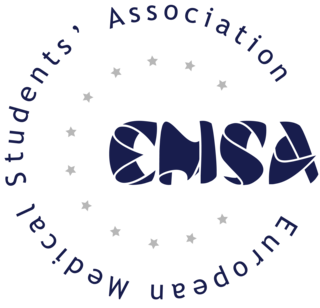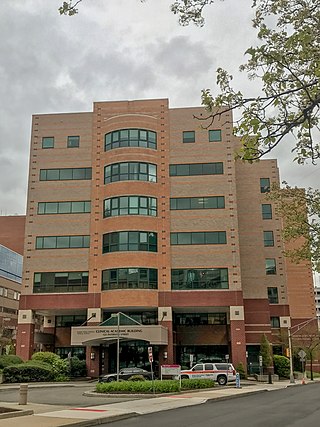
Health informatics is the study and implementation of computer structures and algorithms to improve communication, understanding, and management of medical information. It can be viewed as branch of engineering and applied science.
The Joint Commission is a United States-based nonprofit tax-exempt 501(c) organization that accredits more than 22,000 US health care organizations and programs. The international branch accredits medical services from around the world.

Medical education is education related to the practice of being a medical practitioner, including the initial training to become a physician and additional training thereafter.

The European Medical Students' Association (EMSA) is a non-governmental and non-profit organisation for medical students; it offers opportunities to their members and provides a voice for medical students across Europe, representing their interests to other European institutions and organizations. EMSA was founded in Brussels in 1990. It integrates medical students in Europe through activities organized for and by medical students. EMSA's network and platform encourages medical students from various countries in geographical Europe to actively engage in matters related to health care, medical education, medical ethics, medical science, and general societal well-being, by acting as a conduit for increased interaction and sharing of knowledge between European medical students in these respective areas.

Rutgers Robert Wood Johnson Medical School is a medical school of Rutgers University. It is one of the two graduate medical schools of Rutgers Biomedical and Health Sciences, together with New Jersey Medical School, and is closely aligned with Robert Wood Johnson University Hospital, the medical school's principal affiliate.
The Accreditation Council for Graduate Medical Education (ACGME) is the body responsible for accrediting all graduate medical training programs for physicians in the United States. It is a non-profit private council that evaluates and accredits medical residency and internship programs.

The Queen's Medical Center, originally named and still commonly referred to as Queen's Hospital, is the largest private non-profit hospital in Honolulu, Hawaii. The institution was founded in 1859 by Queen Emma and King Kamehameha IV, and is located in Downtown Honolulu.
The American Board of Medical Specialties (ABMS) is a non-profit organization established in 1933 which represents 24 broad areas of specialty medicine. ABMS is the largest and most widely recognized physician-led specialty certification organization in the United States. The other certification organizations in the United States are the American Board of Physician Specialties and American Osteopathic Association Bureau of Osteopathic Specialists.
Patient safety is a discipline that emphasizes safety in health care through the prevention, reduction, reporting and analysis of error and other types of unnecessary harm that often lead to adverse patient events. The frequency and magnitude of avoidable adverse events, often known as patient safety incidents, experienced by patients was not well known until the 1990s, when multiple countries reported significant numbers of patients harmed and killed by medical errors. Recognizing that healthcare errors impact 1 in every 10 patients around the world, the World Health Organization (WHO) calls patient safety an endemic concern. Indeed, patient safety has emerged as a distinct healthcare discipline supported by an immature yet developing scientific framework. There is a significant transdisciplinary body of theoretical and research literature that informs the science of patient safety with mobile health apps being a growing area of research.
A Patient Safety Organization (PSO) is a group, institution, or association that improves medical care by reducing medical errors. Common functions of patient safety organizations are data collection, analysis, reporting, education, funding, and advocacy. A PSO differs from a Federally designed Patient Safety Organization (PSO), which provides health care providers in the U.S. privilege and confidentiality protections for efforts to improve patient safety and the quality of patient care delivery
Maintenance of Certification (MOC) is a recently implemented and controversial process of physician certification maintenance through one of the 24 approved medical specialty boards of the American Board of Medical Specialties (ABMS) and the 18 approved medical specialty boards of the American Osteopathic Association (AOA). The MOC process is controversial within the medical community, with proponents claiming that it is a voluntary program that improves physician knowledge and demonstrates a commitment to lifelong learning. Critics claim that MOC is an expensive, burdensome, involuntary and clinically irrelevant process that has been created primarily as a money-making scheme for the ABMS and the AOA.

The Brooklyn Hospital Center is a 464-licensed-bed, full-service community teaching hospital located in Downtown Brooklyn, New York City. The hospital was founded in 1845. It is affiliated with the Mount Sinai Health System, and serves a diverse population from a wide range of ethnic backgrounds.

The Society of Hospital Medicine (SHM) is a membership society for hospitalists, physicians, and other caregivers who practice the specialty of hospital medicine.
The University of Connecticut School of Medicine is a medical school located in Farmington, Connecticut. It was founded in 1961, enrolled students in 1968, and graduated its first class in 1972.

The University of Florida College of Medicine – Jacksonville is the largest of the three University of Florida Health Science Center Jacksonville colleges — medicine, nursing and pharmacy. The college's 16 clinical science departments house more than 440 faculty members and 380 residents and fellows. The college offers 34 accredited graduate medical education programs and 10 non-standard programs.
Clinical peer review, also known as medical peer review is the process by which health care professionals, including those in nursing and pharmacy, evaluate each other's clinical performance. A discipline-specific process may be referenced accordingly.
An accountable care organization (ACO) is a healthcare organization that ties provider reimbursements to quality metrics and reductions in the cost of care. ACOs in the United States are formed from a group of coordinated health-care practitioners. They use alternative payment models, normally, capitation. The organization is accountable to patients and third-party payers for the quality, appropriateness and efficiency of the health care provided. According to the Centers for Medicare and Medicaid Services, an ACO is "an organization of health care practitioners that agrees to be accountable for the quality, cost, and overall care of Medicare beneficiaries who are enrolled in the traditional fee-for-service program who are assigned to it".
Aligning Forces for Quality is a U.S. national program of the Robert Wood Johnson Foundation aiming to lift the quality of health care in 16 targeted communities, reduce racial and ethnic disparities in those communities and provide models for national reform. Each regional Health care improvement collaborative aims to create sustainable improvements in health care quality throughout its targeted communities by 2015. To do so, the initiative fosters collaboration among multiple stakeholders in a community. Aligning Forces For Quality focuses its efforts on three main areas: Performance measurement and public reporting, consumer engagement, and quality improvement. Aligning Forces for Quality is the single largest philanthropic effort of its kind undertaken to improve the quality of U.S. health care.
Health care quality is a level of value provided by any health care resource, as determined by some measurement. As with quality in other fields, it is an assessment of whether something is good enough and whether it is suitable for its purpose. The goal of health care is to provide medical resources of high quality to all who need them; that is, to ensure good quality of life, cure illnesses when possible, to extend life expectancy, and so on. Researchers use a variety of quality measures to attempt to determine health care quality, including counts of a therapy's reduction or lessening of diseases identified by medical diagnosis, a decrease in the number of risk factors which people have following preventive care, or a survey of health indicators in a population who are accessing certain kinds of care.
The Society for Vascular Surgery (SVS) is the major national academic society for vascular surgery in the United States. Its mission includes education, research, career development and advocacy. The SVS is the national advocate for more than 6,000 specialty-trained vascular surgeons and other medical professionals who are dedicated to the prevention and cure of vascular disease. The association was founded in 1946. The SVS is the sponsor organization for the Journal of Vascular Surgery (JVS) and for the national Vascular Annual Meeting (VAM). For more than 35 years, the SVS Foundation has been helping vascular surgeons help patients. Strategic priorities include: Research & Innovation; Community Vascular Care & Patient Education; Disease Prevention and Diversity, Equity and Inclusion. Over $14M funded since 1987.







